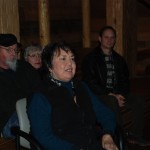 Article and photo by Jeannie Briones
Article and photo by Jeannie Briones
TULALIP, Washington- Makah tribal member Sandra Osawa, is known for her work as a producer, director, and co-owner of Upstream Production. Sandra along with her husband, Yasu Osawa, has created 63 films for various tribes, museums, and non-profit organizations, along with five films that have been broadcasted on PBS. Her production company explores political issues affecting Native American tribes, which is reflected through a variety of documentaries, and contemporary art mediums.
The documentary film “On and Off the Res with Charlie Hill” was featured as part of the Tulalip Hibulb Cultural Center Film Series on November 29th. Sandra directed the film which takes the viewer on an intimate journey through the life of a Native American comedian and his rise to fame.
At an early age, Sandra was aware that Native Americans were being depicted as stereotypes in the media. It wasn’t until she worked for her tribe that she became interested in making films that would correctly represent Native Americans in a more contemporary fashion.
“When I worked for my own tribe at Neah Bay, I was a Community Action Director. I couldn’t find any films relevant to Native people and that began my interest. I decided that I wanted to get into media to see if we can do something about the void in Native American films and to break down stereotypes.”
After working for her tribe for more than three years, Sandra attended UCLA Graduate film school in the 70s. During this time, Sandra notes there were sixteen minority students enrolled in her film class, more than she had ever seen. After working on experimental films, she received her first break in television in 1975.
“We [my husband and I] did a Native American ten-part series[“THe Native American Series”] for NBC Television. Historically that is important because it has become the first major series produced by a Native American for television in the country,” said Sandra. “The topics range from Indian religion, family, treaties, powerless politics, art, stereotypes, and fishing rights in the Northwest. Some colleges are now buying that series for historical archival purposes because it represents the start for Indians in films inAmerica, so I am really happy that it is getting a bit of attention.”
Through her travels and work in Indian Country she has realized the beauty and rich humor Native Americans have. She incorporated those experiences to portray the realistic personality and humor of Native Americans, by presenting films with real images of Native peoples in biographical documentary filmmaking.
“On and Off the Res with Charlie Hill” covers the life of Charlie through his early years as a comedian with brief reflections into his childhood and his family.
“Meeting all the different people that we have come in contact with in all the films, I have gained intimate relationships with each of our subjects and think in turn, it has made the films more powerful,” said Sandra.
Films that Sandra directed include, “Lighting the Seventh Fire” (1995), “Pepper’s Pow Wow”(1996), and “Maria Tallchief “(2007) produced and written by Sandra.
Visit Upstreamvideos.com for listings of her films or you can email Sandra Osawa at uproduct@aol.com.
Jeannie Briones: 360-716-4188; jbriones@tulaliptribes-nsn.gov









 B
B

